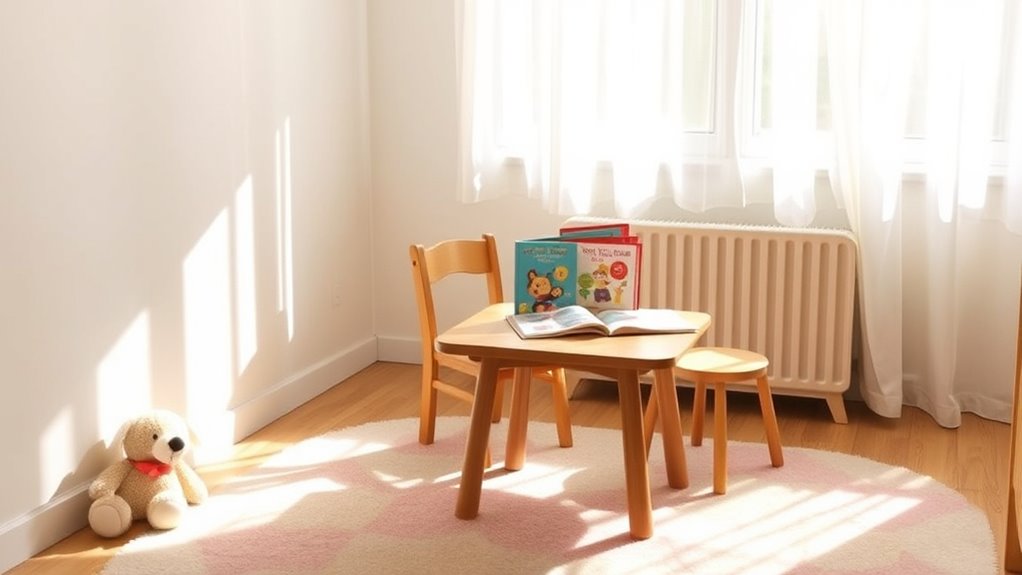To set effective screen time rules for your toddler, focus on quality over quantity by choosing age-appropriate, educational content and watching together to boost understanding. Limit screen time to about an hour daily for children under two, and combine this with plenty of outdoor play and rest. Establish clear routines and boundaries, so your child learns healthy habits early. If you want practical tips to create a balanced media environment, keep exploring for helpful guidance.
Key Takeaways
- Limit screen time to no more than one hour daily for children under two, focusing on high-quality, educational content.
- Parents should select, watch with, and guide toddlers through appropriate media to enhance learning and safety.
- Establish consistent routines that balance screen use with outdoor play, rest, and other developmental activities.
- Use screens as tools for learning, promoting skills like language, problem-solving, and creativity through engaging content.
- Regularly review and monitor screen content to ensure it aligns with developmental goals and family values.

Setting clear screen time rules for toddlers is essential to guarantee they develop healthily and stay engaged in age-appropriate activities. As a parent, you play a vital role in guiding their media consumption, ensuring that what they watch and interact with supports their growth. When establishing these rules, focus on the quality of content, emphasizing educational content that promotes learning and curiosity. Toddlers are naturally eager to explore, so providing them with programs and apps designed specifically for their developmental stage helps foster positive habits and cognitive skills. Parental guidance is key here; it allows you to select appropriate content, monitor their viewing, and set boundaries that prevent overexposure.
To start, set a daily limit for screen time that aligns with recommendations from pediatric experts, generally no more than one hour per day for children under two. Keep in mind, this isn’t just about time but also about how they spend that time. Choose educational content that encourages interaction, problem-solving, and creativity rather than passive watching. For instance, programs that involve songs, stories, or simple educational games can enhance language development and fine motor skills. When you’re involved in choosing and watching content together, you reinforce learning and create opportunities for meaningful engagement. Your active participation offers the necessary parental guidance to help your toddler differentiate between appropriate and inappropriate media. Additionally, understanding cookie types can help you manage online safety and privacy while your child interacts with digital content.
Consistency is crucial in enforcing these rules. Make screen time a part of a daily routine, balancing it with play, outdoor activities, and rest. Explain the rules in simple terms so your toddler understands the boundaries, and stick to them as much as possible. When they know what to expect, they’re more likely to accept limits without tantrums. Remember, the goal isn’t to eliminate screen time but to make it safe, educational, and beneficial. Use screens as tools for learning rather than just entertainment, and always review content beforehand to ensure it aligns with your values and developmental goals. Your ongoing parental guidance will help your child develop healthy habits around technology, fostering a balanced approach that supports their overall well-being and growth.
Frequently Asked Questions
How Can I Set a Good Example With My Own Screen Use?
You can set a good example by practicing parenting consistency with your digital boundaries. Limit your screen use during family time, and avoid screens during meals or before bed. Show your toddler that real-world interactions matter more than screens, which teaches healthy habits. When you model balanced screen time, your child learns to manage their own usage responsibly, reinforcing positive behavior through your consistent actions and boundaries.
Are There Educational Apps Suitable for Toddlers?
Yes, there are educational apps suitable for toddlers that promote interactive learning and support developmental benefits. Look for apps designed specifically for their age, featuring simple navigation and engaging activities. These apps can help develop fine motor skills, language, and problem-solving abilities. Always supervise your child’s screen time, choose high-quality content, and encourage active participation to maximize learning and guarantee a positive experience.
What Are Alternative Activities to Screen Time?
Imagine you’re in a time machine—ditch screens and explore outdoor play with your toddler. You can encourage creative activities like drawing, building with blocks, or singing songs together. These activities boost their development and keep them engaged. Instead of screen time, take a walk, have a picnic, or create a sensory bin. These alternatives foster bonding, imagination, and physical movement, making every moment meaningful and fun for your little one.
How Do I Handle Tantrums Over Screen Time Restrictions?
To handle tantrums over screen time restrictions, stay calm and consistent. Use positive reinforcement by praising your toddler when they follow rules or accept limits. Establish routines that include balanced activities, making passages smoother. Offer alternative engaging activities like coloring or playing outside to distract and redirect their attention. Over time, these strategies help your child understand boundaries and reduce tantrums, creating a more peaceful environment.
When Should I Introduce Screen Time to My Toddler?
Think of introducing screen time like planting a small seed; you start around age 18 to 24 months. At this stage, you can introduce age-appropriate content with strict screen time limits. Just like watering your plant carefully, monitor how your toddler reacts and adjust as needed. Starting early helps set healthy habits, but keeping it limited guarantees your child enjoys screens without overdoing it.
Conclusion
By setting clear screen time rules, you’re planting seeds of balance in your toddler’s world. Think of it as guiding a tiny boat through calm but unpredictable waters—your boundaries keep them afloat while exploring safely. Remember, a little screen time is like a gentle breeze; too much can toss the boat off course. With your steady hand, you help them navigate a healthy digital landscape, nurturing curiosity without losing sight of the real world around them.









